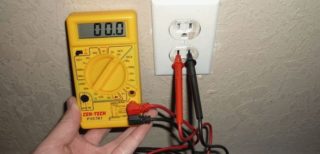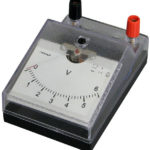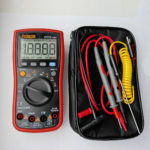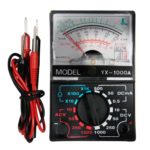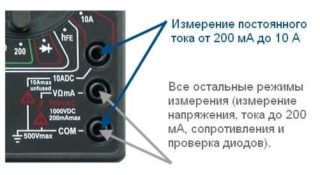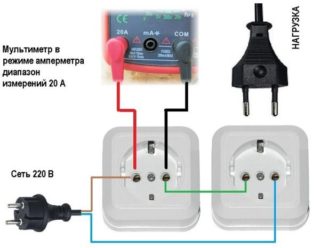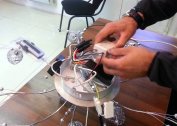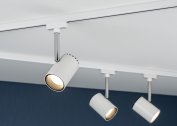To determine if there is voltage in the mains, various types of measuring instruments are used. For example, you can check the voltage in the outlet with a multimeter, since such a device is as functional as possible. Work in compliance with safety rules is quick and easy.
Outlet voltage
The household network provides indicators in the range of 198-242 V. This run-up is optimal for most electrical appliances. But if the voltage in a thunderstorm, for example, jumps to the level of 270 V and above, the equipment, household appliances will simply burn out.
Only alternating current flows in sockets. It is worth remembering this when working with a multimeter.
Why measure voltage
Centralized power supply is provided thanks to a separate winding of a three-phase transformer. A certain number of consumers (houses, apartments) are simultaneously connected to it. Their total number is divided into groups. Each of the castes is connected to one of the three phases (windings) of the transformer. Moreover, its capabilities (power) are limited. If the total load in all apartments exceeds the permissible, the voltage in the electric network drops to 198 V or less. In this case, the operation of household appliances will be incorrect.
Volts are measured in order to ensure the normal operation of electrical appliances in the house. Or to determine the possible causes of equipment malfunctions.
How can I take measurements
Before measuring the voltage in the outlet, it is important to know that for these purposes you can use:
- a voltmeter familiar from the school bench (rare in everyday life);
- a multimeter familiar to many masters (multifunction device);
- a tester, it's a multimeter, but a pointer.
- Laboratory voltmeter
- Multimeter
- Tester
You can also check the availability of mains power with an indicator screwdriver. But it does not show the value of the voltage, but only determines its presence or absence by backlight.
Multimeter measurement
Before checking the voltage in the 220V network with a multimeter, it is advisable to understand the device and the labeling of the device. It is better to use a digital mechanism. It correctly displays information, loyal to the incorrect connection of the probes. In addition, digital measuring instruments are unpretentious to use.
The main components of the multimeter:
- LCD screen to display indicators.
- The wheel used to set the modes (parameters) of the device.
- Test leads (2 pcs.) - red and black. Directly with their help, measurements are made.
In turn, the control wheel has a dial with markings of various test parameters. Their designations are interpreted as follows:
- V = - determination of DC voltage;
- V ~ - AC voltage;
- Ω - allows you to recognize the resistance;
- A = - determination of direct current;
- -hFE - transistor health check;
- o))) - fast continuity of the electrical circuit;
- OFF / ON - turn off / on.
For each of the parameters, nominal measurement ranges are provided. They are indicated on the panel of the multimeter.
Often the icons of constant “=” and alternating “~” currents can be replaced by acronyms DC or AC. For example, to set the control wheel to the parameter for measuring AC voltage, you need to turn it to the acronym ACV or VAC.
Preparatory stage
Additionally, before you measure the voltage with a multimeter in the outlet, it is worthwhile to find out the purpose of all its connectors on the case.
- 10ADC.It is intended only for determining the parameters of direct current. The maximum allowed indicator is up to 10 A. Only the red probe is always inserted into this connector.
- Com. The connector is common. Only a black probe is always connected to it for measurements.
- VΩmA. A connector that is designed to perform all basic measurements, such as current strength (up to 10 A), voltage or resistance.
Most often use the VΩmA connector.
Connecting a multimeter and taking measurements
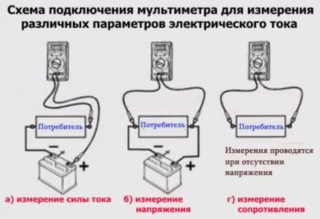 To perform the work you need to properly connect the probes. Red is inserted into the VΩmA connector, and black is inserted into the COM. Next, you need to transfer the control wheel to the desired mode of operation of the device. To determine the voltage it is set to ACV or V ~. In this case, the position of the wheel must be set so that it is at a mark above the estimated mains voltage. For a household power point, a characteristic of 220 V. Typically, you need to set the nearest larger value. For most multimeters, this will be 750 V.
To perform the work you need to properly connect the probes. Red is inserted into the VΩmA connector, and black is inserted into the COM. Next, you need to transfer the control wheel to the desired mode of operation of the device. To determine the voltage it is set to ACV or V ~. In this case, the position of the wheel must be set so that it is at a mark above the estimated mains voltage. For a household power point, a characteristic of 220 V. Typically, you need to set the nearest larger value. For most multimeters, this will be 750 V.
If the master does not know the expected voltage and it turns out to be higher than 750 V, this will lead to an accident. In the best case, the device fuse will burn. At worst, burns to the hands of the master are possible. Therefore, before taking measurements, you should find out the Volt indicator characteristic of the network.
Insert probes into a power outlet
When installing the probes in the power point, it does not matter which one to insert into which socket in the socket. The main thing is to strictly hold the wires for insulation, and not for bare parts. It is important to ensure that the probes do not touch each other. Otherwise, a short circuit will occur.
If the wires are connected correctly, the device’s display will show the current state of things. The digital voltage value appears. It will never be equal to 220 V. An error of +/- 20 is considered the norm. Therefore, if the indicator 235-238 Volts is displayed on the screen, you should not be scared. According to GOST, voltage deviations of 10% are permissible.
Safety precautions

A multimeter is a portable multifunctional measuring device. It is powered by a battery. The device is safe for the master, subject to safety precautions:
- If the master does not know the pre-voltage in the network, you can measure the indicators, but the control wheel must be put on the largest indicator of Volts.
- It is advisable to work in dielectric gloves (it is possible in ordinary household, rubber).
- When determining the network resistance, it is advisable to make sure that the power is completely turned off and the capacitors are reduced to 0 (discharged).
- During operation with a supply point of 20 A, measurements are taken no more than 15 seconds.
- Do not check network performance with a multimeter in high humidity conditions.
- It is forbidden to twist the control wheel and set it to other modes during the measurement process.
- Do not use the device if the braid of the probes is damaged, the case has visible damage.
- The battery of the device is replaced only after the impeller is set to ON and all probes / wires are disconnected. The spent element is disposed of in special waste. Batteries and accumulators must not be disposed of with household waste. This leads to environmental pollution.
Subject to all operating principles and safety precautions, voltage measurement at the outlet takes no more than one minute.
